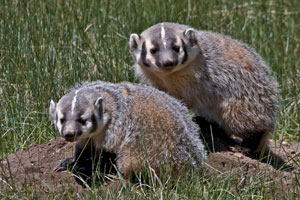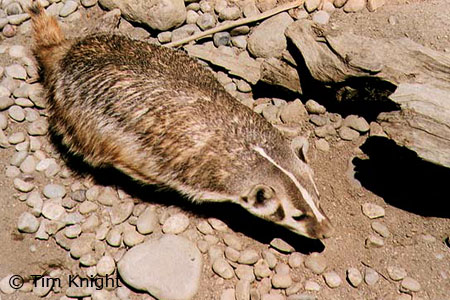

|
American Badger (Taxidea taxus) Description: The Badger is a brown fur-covered mammal with short legs and low profile. The head appears pointed and small for the body. They have short ears and a short, furry tail. Badgers weigh 4 to 12 kg. The body is flattened, and the legs are short and stocky. The fur on the back and flanks of the animal ranges from grayish to reddish. The ventrum is a buffy color. The face of the badger is distinct. The throat and chin are whitish, and the face has black patches. A white dorsal stripe extends back over the head from the nose (see photo).
Badgers prefer to live in dry, open grasslands, fields, and pastures. They are found from high alpine meadows to sea level. Badgers occur in open habitats in eastern Washington including semi-desert, sagebrush, grassland, meadows, and grassy bald spots on high ridge tops. They can be present in open forest (primarily Ponderosa Pine) with grassy ground cover.
Click the range map to learn more about the distribution of Badgers in Washington. Diet: Badgers are carnivorous (meat eater). They eat a variety of small animals, including pocket gophers, ground squirrels, moles, marmots, prairie dogs, woodrats, kangaroo rats, deer mice, and voles. They also eat insects and birds. Behavior: Badgers are solitary animals who are mainly active at night. They tend to be inactive during the winter months. They are not true hibernators, but spend much of the winter in cycles of torpor that usually last about 29 hours. (topor: a state of motor and mental inactivity with a partial suspension of sensibility.) Badgers are known to be excellent digging machines. Their powerfully built forelimbs allow them to tunnel rapidly through the soil and other substrates. They construct underground burrows for protection and sleeping. A typical badger den may be as far a 3 meters below the surface, contain approximately 10 meters of tunnels and an enlarged sleeping chamber. Badgers use multiple burrows within their home range. If threatened, they attack explosively with hissing, growling and biting. 
Reproduction: Mating occurs in late summer or early autumn but embryos are arrested early in development. Development of the zygote pauses at the blastocyst stage, usually for about 10 months, until environmental conditions (day length and temperature) are appropriate for implantation in the uterus. Implantation is delayed until December or as late as February. After this period embryos implant into the uterine wall and resume development. Although a female is technically pregnant for 7 months, the actual gestation is only 6 weeks. Litters of 1 to 5 offspring, with an average of 3, are born in early spring. Females are able to mate when they are as young as 4 months old, but males do not mate until the autumn of their second year. Most females mate after their first year. (Photo courtesy of Natures Pics) Female badgers prepare a grass-lined den before giving birth. Badgers are born blind and helpless with only a thin coat of fur. The eyes of the youngsters open at 4 to 6 weeks old. The young are nursed by their mother until they are 2 to 3 months old. The cubs (young badgers) may emerge from the den as early as 5 to 6 weeks old. Juveniles disperse at 5 to 6 months (source: Animal Diversity Web).
Did you know?

Badger photo by Tim Knight More information: American Badger - Animal Diversity Web Shefferly, N. 1999. "Taxidea taxus" (On-line), Animal Diversity Web. Accessed June 13, 2008 at http://animaldiversity.ummz.umich.edu/site/accounts/information/Taxidea_taxus.html. Eurasian badger: Eurasian badger (Meles meles) - Animal Diversity Web Badgerland (UK)
|
Animal silhouettes available to purchase »
Home | About Us | How to Participate | Biodiversity Modules | Projects | Maps | News | Resources